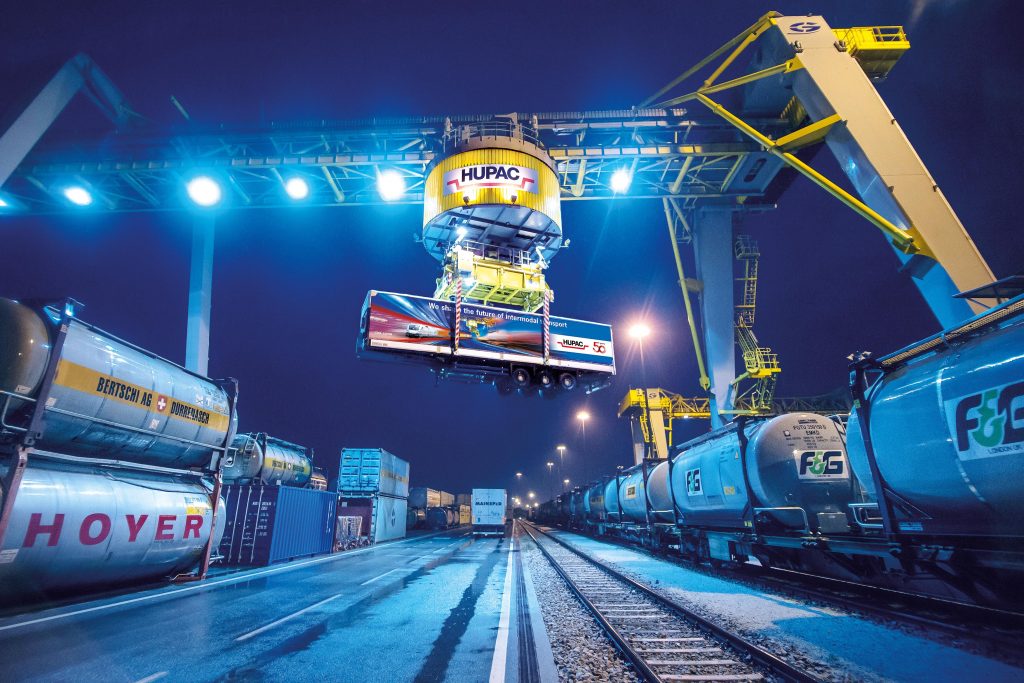Hupac reaches pre-pandemic growth levels, 2022 could slow things down

Hupac scored positive performance results for 2021. The Swiss-based company reached an annual turnover of 631 million euros-14 per cent more than 2020 and a company record-and a profit of almost 12 million euros. The company’s traffic volumes increased by 10 per cent compared to 2019, with 100,000 more trucks shifting to rail and combined transport this year. However, despite the positive results of 2021, 2022 could prove more challenging due to various factors.
“Transalpine traffic through Switzerland grew by 11 per cent to 597,500 road consignments, mainly due to the successful use of the 4-metre corridor via Gotthard. Transalpine traffic through Austria via Tauern also developed favourably, increasing by 7,8 per cent compared to the previous year. Via France, traffic increased by 26,3 per cent from a low level. Non-transalpine traffic also developed dynamically with a growth rate of 10,4 per cent and reached a volume of 479,200 road consignments. The segments south-east and south-west Europe contributed significantly to this”, explained the company.
Nevertheless, Transalpine traffic could hinder further growth in 2022 because of the extended construction works planned on the Rhine-Alpine Corridor throughout the year. Hupac, though, has plans to counterbalance them.
Economic slowdown in 2022
In the first quarter of 2022, Hupac recorded traffic growth of around 4 per cent. In April, the traffic volume was below the previous year’s level. This was due to the three weeks of construction on the Rhine Valley route, which halved transport capacity. “We expect the construction sites scheduled for the summer to be planned much better and more freight-friendly on the rail side, and we will campaign for this at all levels,” said Hupac’s CEO Michael Stahlhut.
The war in Ukraine and China’s lockdown policy will also play a role in decelerating the company’s economic advance. “The war in Ukraine renewed disruption of global supply chains. On top of that, the current Covid situation in China and the upcoming interest rate rises due to high inflation make 2022 a challenging year. Predictions are difficult in this situation, but at the end of the year, Hupac expects a single-digit growth percentage”, highlighted Hans-Jorg Bertschi, chairman of Hupac’s board of directors.
Resilience top priority
At least for the factors, like the Rhine-Alpine traffic that Hupac can influence, the company has devised some concrete plans. The war in Ukraine and China’s lockdown policy might be out of Hupac’s hands; however, this is not the case for Transalpine traffic. “The primary goal is to stabilise quality on the various routes, especially on the transalpine lines marked by intensive construction activity. We will manage the performance of our network even more actively in the future,” said Stahlhut. “We also expect a corresponding effort from our rail partners. Our declared goal is quality leadership. If the quality is right, traffic growth will come all by itself”, added Stahlhut.
The company’s CEO demanded that passenger and freight traffic be treated equally on the Rhine-Alpine route. This would be one prerequisite for stability during construction periods. Not relying only on the decision of infrastructure managers, though, Hupac came up with some measures that will allow it to continue rail freight operations in the corridor efficiently no matter the situation. These measures are:
- Increase of wagons for reserve train compositions by 50% to 12% of the fleet in transalpine traffic
- Strengthening of the disturbance management in close cooperation with the railway partner
- Relieving the load on the Busto Arsizio-Gallarate terminal through diversification via other terminals in the greater Milan area
- Additional complementary offers to the Rhine-Alpine corridor via other transalpine corridors
- Additional offer of substitute connections in case of planned major construction sites
- Increase of the locomotive driver team that Hupac keeps under contract for ad-hoc operations in case of breakdowns
Terminals and millions in investments for growth
Resilience is not the only goal for Hupac, however. The intermodal company aims to grow more in the coming few years. Turning more trucks to rail and building an extensive terminal network seems to be the approach for this target. “For the strategy period 2022-2026, the company is targeting an annual volume increase of 7 per cent. With a forecast economic growth of 2 per cent, this will achieve a real shift of truck traffic from road to rail. By 2026, Hupac aims to achieve a traffic volume of 1,6 million road consignments per year, representing an increase of 40 per cent compared to 2021. The board of directors has approved an investment programme of around 250 million euros to achieve this goal”, explained Hupac.
The company also underlined that a key factor in succeeding in the traffic growth goals is the terminal investments. Hupac’s terminal in Brinow next to Warsaw in Poland will be ready for operations by the end of 2022. The company has more major terminal plans underway. In Italy, for instance, the company aims to build two large scale terminals in cooperation with Mercitalia by the end of 2025. They will complement operations in Piacenza and Milano Smistamento and will be located in Northern Italy. Moreover, Hupac plans to expand the capacity of the Novara CIM Terminal, of which it became operator a few months ago.
Finally, Hupac also participates in the construction of two more terminals. The Duisburg Gateway Terminal expected in 2025, and the Basel Nord Terminal expected in 2026.
Also read:
-
Gateway Basel Nord to become a nature conservation transport hub
-
Hupac: ‘what we need now, is an electricity subsidy for rail’
You just read one of our premium articles free of charge
Want full access? Take advantage of our exclusive offer





